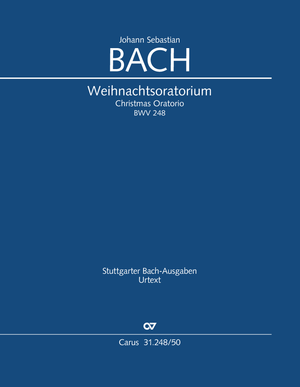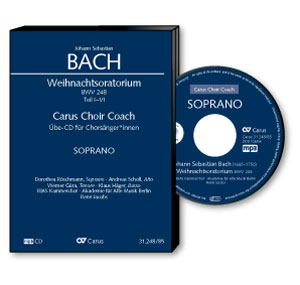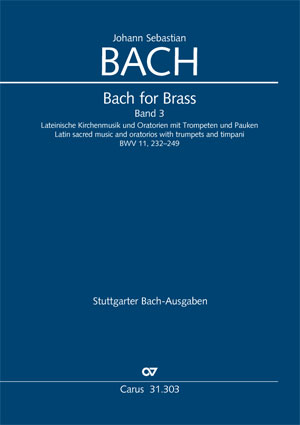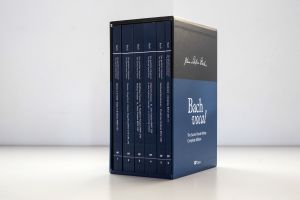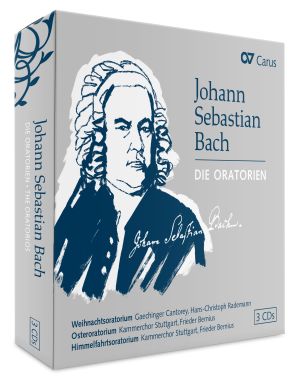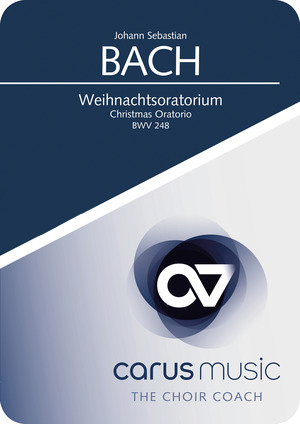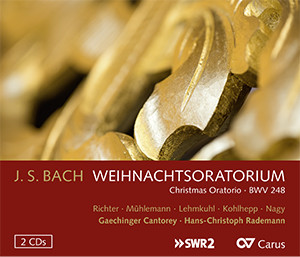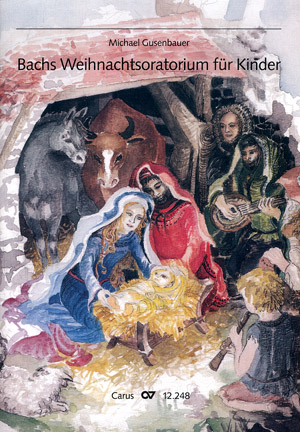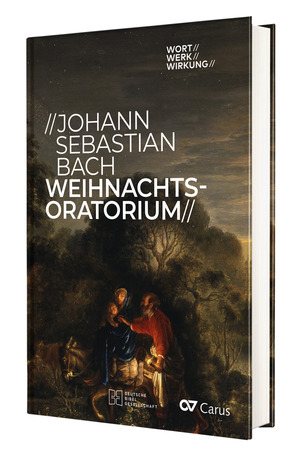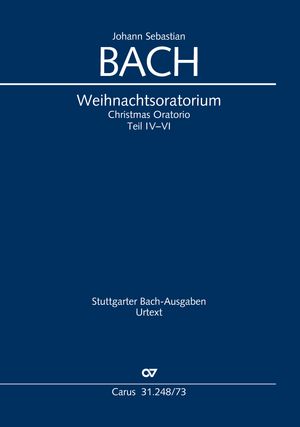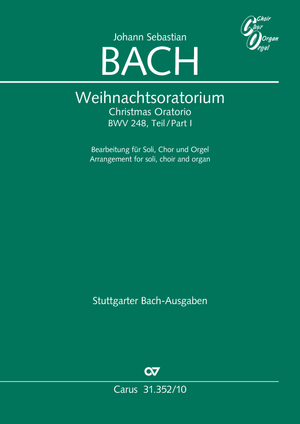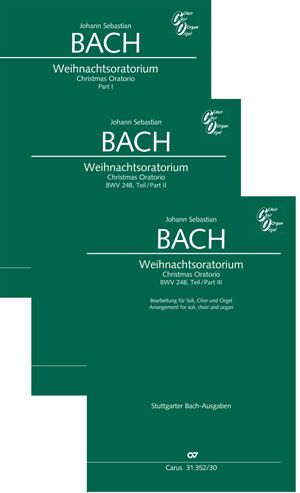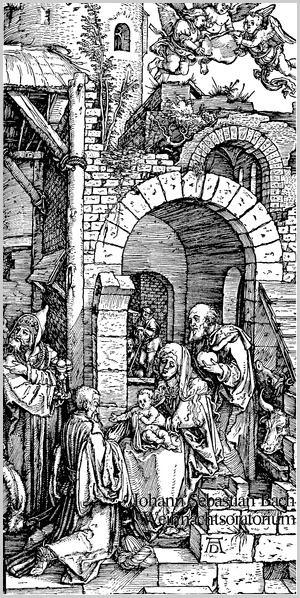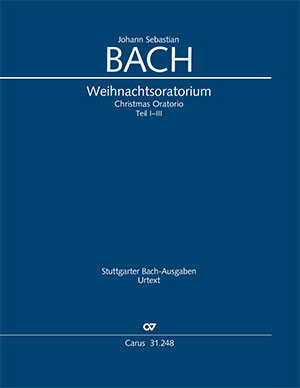
With the edition of the Christmas Oratorio within the framework of the Stuttgart Bach Editions, Carus presents a scholarly edition for practical performance. The basis for this publication are Bach’s autograph score and the original parts. The conducting score contains an appendix with a concise Critical Report which provides information about the sources and their readings; when necessary, the latter are discussed in more detail, especially with regard to how the editor arrived at solutions for questions of articulation which differ from those found in previous editions. The representative, clothbound volume is supplemented by a study score as well as a choral score, a vocal score and complete orchestral material. In the orchestral material short excerpts containing the conclusions of the secco recitatives are rendered with cue notes in separate vocal systems printed above the score where the instrumentalists pause, thus enabling them make their entrances in the movements which follow these recitatives.
This work is also available in carus music, the choir app!
-
Composer
Johann Sebastian Bach
| 1685-1750Johann Sebastian Bach is one of the most important composers of Western music history. He came from a widely ramified musical dynasty, which produced numerous musicians and organists in the Thuringian-Saxon area.
Bach vocal
Ever since Carus-Verlag was founded in 1972, publishing the music of Johann Sebastian Bach has been a special focus for us. In the 2017 Reformation anniversary year we completed the Bach vocal project. Bach's complete sacred vocal works are now available in modern Urtext editions, together with performance material. A complete edition of all the full scores is also available in a high quality box set. Personal details
-
Editor
Klaus Hofmann
| 1939
-
Continuo realization
Paul Horn
| 1922-2016Paul Horn war ein deutscher Kirchenmusiker, Organist, Komponist und Musikwissenschaftler. Er studierte Kirchenmusik und Orgel an der Evangelischen Kirchenmusikschule Esslingen am Neckar bei Hans-Arnold Metzger und Musikwissenschaft, Theologie und Geschichte an der Universität Tübingen. Seine berufliche Laufbahn begann als Kantor an der Evangelischen Michaelskirche in Stuttgart-Degerloch. 1954 wurde er Kantor an der Evangelischen Stadtkirche Ravensburg, eine Position, die er bis zu seiner Pensionierung innehatte. Als Musikwissenschaftler arbeitete Horn bis ins hohe Alter eng mit Carus zusammen. So stammen zahlreiche Carus-Klavierauszüge aus seiner Feder. Personal details
Reviews
In knappen Worten führt der Herausgeber in die Besonderheit der Gattungszugehörigkeit und – geschichte, der Textgrundlage, des Parodieverfahrens, der Wiederentdeckung und heutigen Rezeption dieses Werkes ein. Besonders verdienstvoll ist dabei die Zuordnung der Texte und Melodien der Choralstrophen zu ihrer Herkunft. ... Wer sich heute für ein Aufführungsmaterial zu entscheiden hat, sollte Carus ernsthaft in die Überlegung einbeziehen.
Württembergische Blätter für Kirchenmusik, 2007
Der (Kritische Bericht) ist freilich, zusammen mit dem dreiseitigen (zweisprachigen) Vorwort ein großer Gewinn, ... zum genauen Studium ... unentbehrlich.
Musica Sacra, Heft 1 2007
Ein ausführlicher und spannender kritischer Bericht von 18 Seiten gibt über die neu erworbenen Details Auskunft.
Musik und Liturgie, Januar 2007
Wer ... noch kein Weihnachtsoratorium im Notenschrank hat, sollte sich die Carus-Version näher ansehen, die kürzlich in der Reihe der Stuttgarter Bach-Ausgaben erschienen ist. Denn die liefert so ziemlich alles, was heute nötig ist ...: Das ist zuallererst und hauptsächlich natürlich die solide Grundlage, ein zuverlässiger Notentext auf Basis des Urtexts, der von Klaus Hofmann, dem Leiter des Göttinger Johann-Sebastian-Bach-Instituts und maßgeblichen Mitarbeiter an der Neuen Bach-Ausgabe editiert wurde. Der garantiert schon einmal einen wissenschaftlich abgesicherten und aktuellen Notentext - nicht, dass das beim Weihnachtsoratorium ein besonderes Problem wäre. Dazu kommt dann der ordentliche und übersichtliche Druck, wie man ihn vom Carus-Verlag gewöhnt ist. Und außerdem die Generalbassaussetzung und ein Klavierauszug von Paul Horn, der selbst Kirchenmusiker ist und mit über 900 Klavierauszügen bzw. Generalbassaussetzungen ein echter Routinier auf diesem Gebiet. Entsprechend praxistauglich fällt seine Arbeit denn auch aus: vergleichsweise einfach zu spielen, großzügig mit Anmerkungen zur Instrumentation etc. versehen - also eine wirklich im besten Sinne praktische Ausgabe für die Einstudierung bestens geeignet. Carus kommt den finanzschwachen Chören, die sowieso nur die ersten Teile des Weihnachtsoratoriums aufführen wollen, noch entgegen und bietet auch eine zweigeteilte Ausgabe (mit den ersten drei Kantaten bzw. den letzten drei Kantaten in separaten Bänden) an.
Matthias Mader, Neue Chorzeit, 12/2006
Bachs Weihnachtsoratorium steht in der Tradition der Weihnachtshistorie. Das Evangelium wird wie in den Passionen in musikdramatischer Weise durch Soloteile und einen Chor für die Engel und Hirten verarbeitet. Bach fügt dem noch einige Erweiterungen durch Kirchenliedeinlagen und freigedichtete, solistische Strophenarien hinzu. Die Mehrzahl der Chöre und fast alle Arien dieses Werkes sind durch Parodierung früherer Kompositionen gewonnen, stammen meist aus weltlichen Kantaten.
Ursprünglich komponiert als Zyklus von 6 Einzelwerken, die in den Gottesdiensten der Weihnachtszeit als Hauptmusik anstelle der Kantate musiziert wurden, hat sich die Praxis etabliert, die ersten 3 Teile innerhalb eines Konzerts zur Aufführung zu bringen. Die vorliegende Ausgabe trägt dieser Entwicklung Rechnung. Ein umfangreicher kritischer Bericht und das ausgezeichnete Notenbild des Carus-Verlags sind Garant für eine hohe Akzeptanz der neuen Ausgabe.
Musik im Bistum Essen I/2000
Eine weit verbreitete Aufführungsform des Weihnachtsoratoriums ist die ausschließliche Darbietung der Teile I bis III. Sie sind denn auch in ihrer Konzentration auf das eigentliche Weihnachtsgeschehen ein abgerundetes Ganzes. Die vorliegende Ausgabe ist mit ihrer Bündelung der Teile I-III speziell für diese Aufführungsform gedacht.
(Singen und Musizieren im Gottesdienst, Juli/August 2000
Der Klavierauszug besticht durch seine Praxisfreundlichkeit: bei jedem Stück werden die beteiligten Instrumente erwähnt, wenn abwechselnd, sogar noch an der Stelle des Auftretens.
Württembergische Blätter für Kirchenmusik, März/April 2006
Der Klavierauszug zeichnet sich ... durch gutes Druckbild aus, wobei jeder Vokalstimme ein eigenes system zugewiesen ist.
Singende Kirche, Januar 2001
Besondere Erwähnung bedarf der durchsichtig ausgearbeitete Klavierauszug von Paul Horn.
Musik im Bistum Essen, Januar 2001
Frequent questions about this work
What is the situation regarding the source material for J. S. Bach’s Christmas Oratorio?
Can the Carus edition of the Christmas Oratorio be used with other editions?
What is special about the Carus edition of the Christmas Oratorio?
Are Parts I-III and IV-VI of the Christmas Oratorio also available in separate editions?
 There are no questions and answers available so far or you were unable to find an answer to your specific question about this work? Then click here and send your specific questions to our Customer Services!
There are no questions and answers available so far or you were unable to find an answer to your specific question about this work? Then click here and send your specific questions to our Customer Services!


